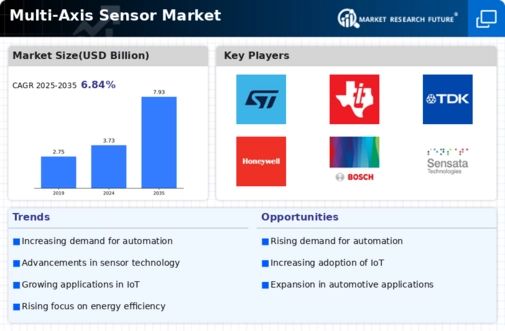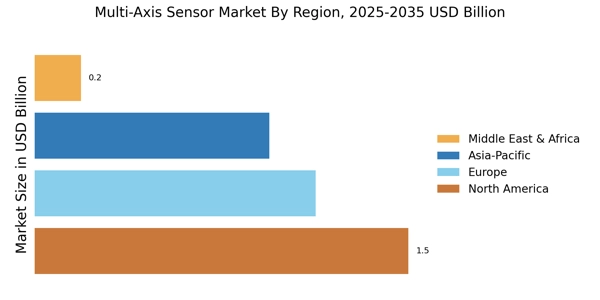Expansion in Consumer Electronics
The Multi-Axis Sensor Market is witnessing significant growth due to the expansion of consumer electronics. Devices such as smartphones, tablets, and wearables increasingly rely on multi-axis sensors for enhanced user experiences. These sensors enable functionalities like motion detection, orientation sensing, and gesture recognition, which are essential for modern applications. Market data indicates that the consumer electronics segment is expected to grow at a compound annual growth rate (CAGR) of approximately 10% through 2025. This growth is fueled by the rising consumer demand for innovative features and the continuous evolution of technology, prompting manufacturers to integrate advanced multi-axis sensors into their products.
Rising Demand in Automotive Sector
The Multi-Axis Sensor Market is experiencing a notable surge in demand, particularly within the automotive sector. As vehicles increasingly incorporate advanced driver-assistance systems (ADAS), the need for precise motion sensing has escalated. Multi-axis sensors facilitate critical functions such as stability control, navigation, and collision avoidance. According to recent data, the automotive segment is projected to account for over 30% of the total market share by 2025. This trend is driven by the growing emphasis on safety and automation in vehicles, which necessitates the integration of sophisticated sensor technologies. Consequently, manufacturers are investing in the development of high-performance multi-axis sensors to meet these evolving requirements.
Emerging Applications in Healthcare
The Multi-Axis Sensor Market is also experiencing growth due to emerging applications in the healthcare sector. Multi-axis sensors are being integrated into medical devices for monitoring patient movement and vital signs. This integration enhances the capabilities of wearable health technologies, allowing for more accurate tracking of patient conditions. Recent data suggests that the healthcare segment is anticipated to grow at a CAGR of approximately 9% by 2025. This trend reflects the increasing demand for innovative healthcare solutions and the need for real-time monitoring, which is driving the adoption of multi-axis sensors in medical applications.
Growing Focus on Robotics and Drones
The Multi-Axis Sensor Market is benefiting from the growing focus on robotics and drone technology. As these sectors expand, the demand for precise motion sensing capabilities becomes increasingly critical. Multi-axis sensors are integral to the functionality of robotic systems and unmanned aerial vehicles (UAVs), enabling accurate navigation and stability. Market analysis reveals that the robotics and drone segments are expected to witness substantial growth, with projections indicating a CAGR of over 12% through 2025. This growth is driven by advancements in technology and the increasing application of robotics in various fields, including logistics, agriculture, and surveillance.
Increased Adoption in Industrial Automation
The Multi-Axis Sensor Market is significantly influenced by the increased adoption of automation in industrial settings. As industries strive for greater efficiency and precision, multi-axis sensors play a crucial role in monitoring and controlling machinery. These sensors provide real-time data on motion and orientation, which is vital for optimizing production processes. Recent statistics suggest that the industrial automation sector is projected to grow at a CAGR of around 8% by 2025, further driving the demand for multi-axis sensors. This trend indicates a shift towards smart manufacturing, where the integration of advanced sensor technologies is essential for maintaining competitive advantage.
















Leave a Comment